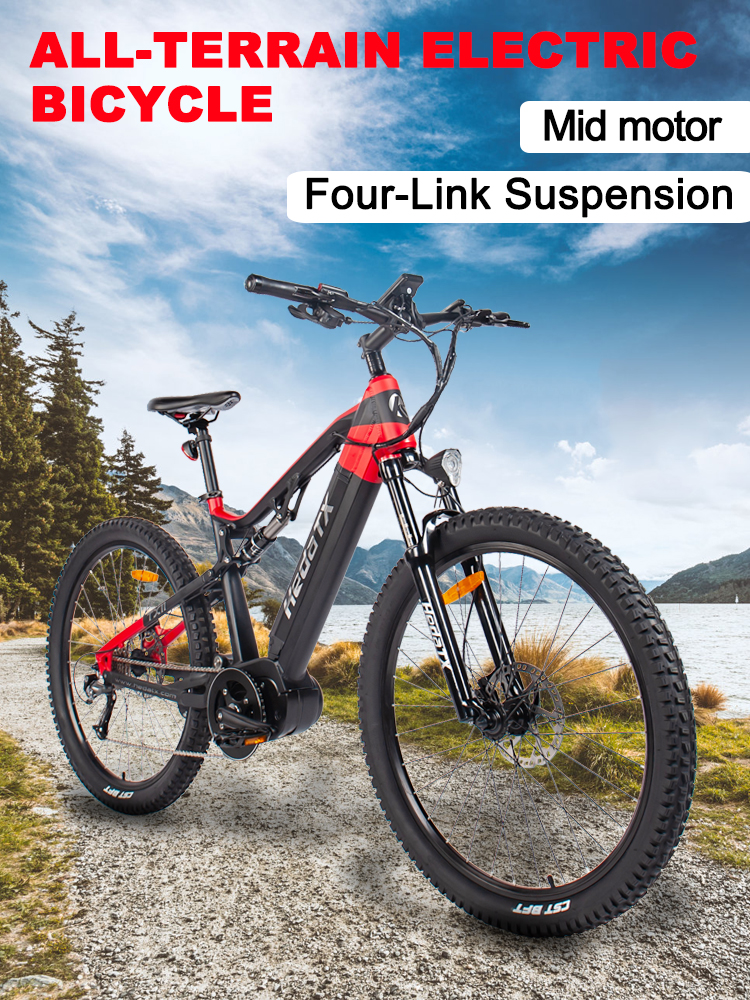
Privacy statement: Your privacy is very important to Us. Our company promises not to disclose your personal information to any external company with out your explicit permission.
News
Home > Exhibition News > The driving time of an electric bicycle determines the factors
2024-09-09

The impact of battery capacity on endurance
Definition and unit: Battery capacity is the amount of electrical energy that a battery can store, usually expressed in ampere-hours (Ah). It represents the duration of the current value that the battery can provide under specified conditions.
The larger the battery capacity, the more electricity the battery can store, so the farther the Electric Bike can travel on a single charge. For example, at the same voltage, a 48V20Ah battery will significantly increase its range compared to a 48V12Ah battery.
Practical application: When purchasing an Electric Bicycle, consumers usually pay attention to the capacity of the battery to determine whether its endurance meets the needs of daily travel. Some high-end e-bikes even come with detachable high-capacity batteries to provide longer ranges.
The effect of battery type on endurance
Main types: Battery types commonly used for electric bicycles include lead-acid batteries, lithium-ion batteries, and so on. Different types of batteries differ in energy density, weight, life, etc., which affects the endurance performance of electric bicycles.
Influence mechanism:
Energy density: Lithium-ion batteries generally have a higher energy density than lead-acid batteries, so for the same weight, lithium-ion batteries are able to store more electrical energy, which provides a longer range.
Weight: The weight of the battery will also affect the battery life of the electric bike. The lighter battery can reduce the overall weight of the e-bike and reduce the energy consumption during driving, thus helping to improve the battery life. However, it should be noted that lightweight batteries are often accompanied by higher costs.
Life: The life of the battery also affects its performance. The long life of the battery can reduce the frequency of replacement, thereby indirectly improving the overall endurance of the electric bicycle.
Practical application: With the advancement of technology and the reduction of cost, more and more electric bicycles have begun to use lithium-ion batteries as a power source. These batteries not only have higher energy density and longer life, but also support fast charging functions to further enhance the user's riding experience.
The effect of motor efficiency on battery life
Definition and importance:
Motor efficiency refers to the efficiency of the motor to convert electrical energy into mechanical energy, that is, the ratio of the output power of the motor to the input power. The high-efficiency motor can make more efficient use of electric energy and reduce energy loss, thus improving the endurance of electric bicycles.
Influence mechanism:
When the motor efficiency is higher, the same electrical energy input can produce more mechanical energy output, pushing the electric bicycle to travel longer distances.
On the contrary, if the motor efficiency is low, there will be more energy loss in the process of converting electrical energy into mechanical energy, resulting in a decline in the endurance of electric bicycles.
Practical application:
In the design and manufacturing process of electric bicycles, manufacturers will use advanced motor technology and materials to improve the efficiency of the motor. For example, the use of permanent magnet synchronous motors, optimization of motor structure and control algorithms can effectively improve motor efficiency.
The effect of motor power on battery life
Definition and unit:
Motor power refers to the work done by the motor in unit time, usually expressed in watts (W) or kilowatts (kW). It determines the power performance and acceleration ability of the electric bicycle.
Influence mechanism:
The greater the motor power, the stronger the power performance and acceleration ability of the electric bicycle, but at the same time, it will consume more electric energy. Therefore, in the case of a certain battery capacity, the greater the motor power, the range of the electric bicycle will be shortened accordingly.
On the other hand, if the motor power is too small, although it can save energy, it may not be able to meet the power needs of users, affecting the riding experience.
Practical application:
In the purchase of electric bicycles, users need to choose the appropriate motor power according to their actual needs and riding environment. In general, for daily commuting and short-distance travel, moderate motor power can meet the needs; For users who need to climb frequently or pursue acceleration performance, you can choose a high-power motor

Vehicle weight and design
The effect of vehicle weight on endurance
Weight and energy consumption:
The weight of electric bicycles is one of the important factors affecting their energy consumption. In general, the heavier the vehicle, the greater the inertial force that needs to be overcome when driving, thus consuming more electrical energy. Therefore, in the case of a certain battery capacity, the increase in the weight of the vehicle will lead to the reduction of the driving range.
Lightweight design:
In order to improve the endurance of electric bicycles, manufacturers often use lightweight designs to reduce the weight of the vehicle. This includes the use of lightweight materials (such as aluminum alloy, carbon fiber, etc.) to manufacture frames and components, as well as optimizing vehicle construction to reduce unnecessary weight. The lightweight design helps to reduce energy consumption, thereby increasing driving range.
Aerodynamic design:
The aerodynamic design of the vehicle also has an important impact on the range. The streamlined design can reduce the air resistance of the vehicle during driving, thus reducing energy consumption. Some high-end electric bicycles use aerodynamic design, such as low wind resistance body, streamlined front, etc., to improve endurance performance.
Drive system efficiency:
The efficiency of the transmission system is also directly related to the endurance of the electric bicycle. An efficient drivetrain reduces the loss of energy during transmission, thereby increasing the range. Therefore, manufacturers will continue to optimize the design and manufacturing process of the drive system to improve its efficiency.
Battery layout and heat dissipation:
Battery layout and thermal design also have a certain impact on battery life. A reasonable battery layout can ensure that the battery maintains a stable temperature during driving and avoid affecting performance due to overheating. At the same time, a good heat dissipation design also helps to extend the service life of the battery and maintain its stable performance, thereby improving the battery life.
Riding mode and auxiliary functions:
Electric bicycles usually offer a variety of riding modes (such as pure electric mode, power mode, pedal mode, etc.) and auxiliary functions (such as energy recovery braking system, etc.). The design of these modes and functions will also affect the endurance of electric bicycles. For example, energy recovery braking systems can convert part of the kinetic energy into electrical energy when slowing down or braking to be re-stored in the battery, thereby improving energy utilization and endurance..
Temperature factor
Low temperature environment: In a low temperature environment, the chemical activity of the battery will be reduced, resulting in a decrease in the capacity and performance of the battery, which will affect the mileage of the electric bicycle. In addition, low temperatures may also increase the driving resistance of the vehicle, such as the rolling resistance of the tire and the ground, further reducing the driving range.
High temperature environment: Although the direct impact of high temperature on battery capacity is relatively small, long-term high temperature exposure may accelerate the aging of the battery, reduce the service life of the battery, and indirectly affect the battery life. In addition, high temperatures may overheat components such as motors, affecting work efficiency.
Road condition
Road conditions: Smooth and smooth road conditions are conducive to reducing resistance and improving the driving range of electric bicycles. Bumpy or potholed roads increase driving resistance and consume more power.
Slope and altitude: When driving on steep roads or at high altitudes, electric bicycles need to overcome gravity to do work, thus consuming more power. Therefore, driving in these conditions will significantly shorten the range.
Wind speed and direction
Wind speed: Strong winds will increase the driving resistance of electric bicycles, especially when driving against the wind. In order to overcome wind resistance, e-bikes need to consume more power to maintain speed, which reduces the range.
Wind direction: When the wind is downwind, the electric bicycle can use the wind to move forward, reducing energy consumption; When upwind, the opposite is true. Therefore, the wind direction is also an important factor affecting the endurance of electric bicycles.
Load condition
Vehicle load: The greater the weight carried by the electric bicycle, the greater the inertial force needed to overcome when driving, thus consuming more electricity. Therefore, when carrying heavy objects or riding with many people, the mileage of electric bicycles will be shortened accordingly.
Driver's weight: The weight of the driver will also have a certain impact on the endurance of the electric bicycle. Heavier drivers use more energy while driving.
Acceleration and deceleration modes
Frequent rapid acceleration: Rapid acceleration causes the current to increase instantaneously, consuming more power. Frequent sharp acceleration can significantly reduce the range of an e-bike.
Smooth acceleration: In contrast, smooth acceleration can make more efficient use of electrical energy and reduce unnecessary energy waste, thus extending the range.
Sudden braking: Sudden braking will not only increase the wear of the brake system, but also convert part of the kinetic energy into heat during the braking process, which will also reduce the endurance of the electric bicycle.
Predictive deceleration: By observing road conditions ahead of time and slowing down predictably, you can reduce unnecessary braking operations and save energy.
Travel speed
High-speed driving: When the electric bicycle is driving at high speed, the wind resistance will increase significantly, resulting in an increase in energy consumption. In addition, high-speed driving may also put components such as motors and batteries in a high load state, further shortening the range.
Economic speed: Each electric bicycle has a relatively economic speed range, in this range can maximize the use of electric energy, extend the mileage.
Load management
Reasonable load: Arrange the load reasonably according to the carrying capacity of the electric bicycle to avoid overload. Overloading increases the resistance of an e-bike, which consumes more power.
Reduce unnecessary items: Regularly clean unnecessary items on the electric bicycle, reduce the weight of the vehicle, and help improve the endurance.
Riding mode selection
Pure electric mode: Choose pure electric mode when you need to drive fast or climb hills, but pay attention to control the driving time and speed to save power.
Power mode: Choose the power mode when the road is flat or you need to save energy, and drive through the combination of manpower and electricity, which can effectively extend the driving range.
Pedal mode: The pedal mode can be selected for short distances or low intensity driving, completely relying on human riding, without consuming electrical energy.
Regular maintenance and maintenance
Battery maintenance: Check the battery status regularly to ensure that the battery is fully charged and avoid overcharging or overdischarging. It is also important to keep the battery clean and dry.
Tire pressure: Keep the tire pressure within the normal range, too low pressure will increase the driving resistance and consume more power.
Transmission system inspection: Regularly check the transmission system (such as chain, gear, etc.) is smooth without stutter, to ensure energy transfer efficiency.

Share to:
Send Inquiry

Mr. Leo
Tel:+86-0757-81092607
Fax:+86-0757-81092967
Mobile Phone:8617718868618
Email:hedatx2023@hotmail.com
Address:6/F, No.18 South, Wujia Development Zone, Xilian, Danzao Town, Nanhai District, Foshan, Guangdong
Related Products List
Mobile Site


Privacy statement: Your privacy is very important to Us. Our company promises not to disclose your personal information to any external company with out your explicit permission.

Fill in more information so that we can get in touch with you faster
Privacy statement: Your privacy is very important to Us. Our company promises not to disclose your personal information to any external company with out your explicit permission.